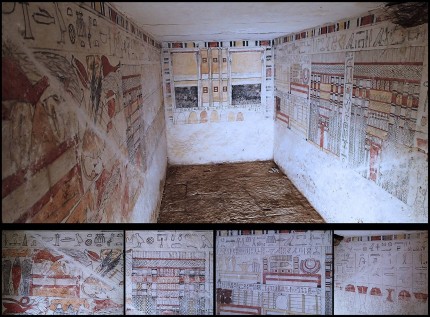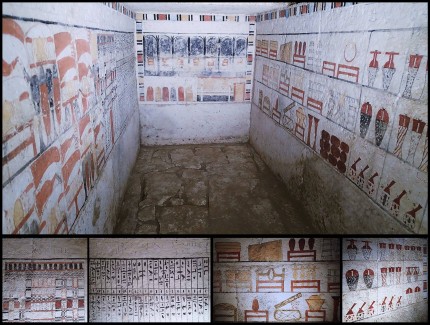
Archaeologists excavating the site of Tabit El-Geish, south of Saqqara, have discovered two vividly painted tombs from the reign of 6th Dynasty pharaoh Pepi II (2,278–2,184 B.C. [yes, you read that right, a reign of 94 years, although the end date is disputed so he may have “only” reigned 64 years]). The discovery was made by the mission of the Institut Français d’Archéologie Orientale (IFAO) under the direction of Dr. Vassil Dobrev in collaboration with the Egyptian Ministry of Antiquities.
Both tombs were built on two levels: a top one on the surface made of mud brick, and a burial chamber below cut out of the white limestone bedrock. The burial chambers were both deep under the ground. The first tomb discovered belonged to a high priest named Ankh Ti and his burial chamber was 12 meters (40 feet) deep. The second tomb belonged to a priest named Sabi whose burial chamber was six meters (20 feet) deep.
The paintings decorate the walls of the limestone burial chambers and they are in excellent condition, their colors still bright more than 4,000 years after they were painted. Ankh Ti’s burial chamber paintings depict scenes of offerings to the gods including seven large jars used to contain the seven sacred oils necessary for the Opening of the Mouth ritual which made it possible for the deceased to eat and drink in the afterlife. On the left wall there is a lists of names of offerings and the quantity offered in a handsomely organized graph. (Old Kingdom Egyptians had spreadsheets down pat for at least three centuries by the time these tombs were built.) Next to the list is a false door with depictions of offerings including meat, birds, bread, vegetables, roses, milk and beer. Other scenes show incense balls, copper burning incense, head rests and the necklaces worn by priests during the performance of these rituals. Sabi’s tomb has similar paintings of the offerings and the list.
Human remains were found inside both burial chambers, but they were scattered about and there were no sarcophagi, the result of looting in antiquity, probably in the waning days of the Old Kingdom during the 7th or 8th Dynasty. The tombs weren’t completely emptied of artifacts by the thieves. Archaeologists found some funerary tools, alabaster jars, pottery and some colored limestone offering models.
The paintings and artifacts indicate Ankh Ti and Sabi were involved in mummification and funerary rituals as part of their priestly duties. The decoration of their tombs and the accessories buried with them were chosen to reflect the work they did in life.

Let’s hope that ISIS don’t get at them.
A small point: I don’t understand “copper burning incense”.
I can read that.
I so enjoy this blog!
From what little I know of egyptology, the process of mummification was considered ‘unclean’ and, as a result, those who practiced it faced some societal restrictions re: contact with others, where they could and couldn’t go, etc.
Even worse was a particular ritual involving the embalmer who opened up the body to be mummified, as described by Diodorus Siculus:
While I’d assume high priests like Ankh Ti and Sabi were less (if at all) affected by any such stigma attached to mummification, I still wonder if there are any depictions on either of their tomb’s walls of such customs??
Of course, any portrayal or description of the mummification process itself are highly unlikely on any of the tombs walls — apparently the ancient Egyptians never wrote it down at any point despite their civilization surviving for three millennia.